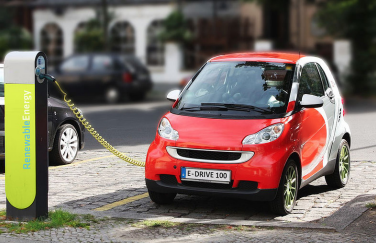Reducing transport emissions - are electric vehicles really the solution?
Boris Johnson is requiring all houses to have EV charging stations... is this the right move?

A new announcement by Prime Minister Boris Johnson on November 22nd stated that all new homes built from next year onwards would be required to have electric vehicle charging capacity. The UK’s transportation sector accounts for approximately 27% of emissions, and this law, which will see an estimated 145,000 new charging points, is anticipated to drive the transition towards more sustainable modes of transport (pun intended).
The electric vehicle (EV) market has boomed in the last few years, with sales in the UK increasing from 2.5% of all cars sold in 2018 to 10% by 2020. But one of the roadblocks to further expansion has been the lack of charging infrastructures—an issue further compounded by the high cost of using public ones. Home charging stations that are cheaper should help overcome this.
But are EV’s and their charging stations really the solution to reduce transportation emissions for good? Although the new law does sound like we’re heading in the right direction, it still has complications that must be overcome.
Firstly, if we want the whole of the UK to gradually increase EV adoption, we must address the existing disparity in the availability of charging stations between the North and South of the UK. Much of the rural regions are lagging far behind in the transition. Even if home charging stations are put in place, it becomes incredibly difficult for individuals to make the switch if public ones aren’t readily available.
This also means that those in urban areas who purchase an EV might struggle when it comes to driving into the countryside. The unreliability of EV long-distance travel is also exacerbated by the impacts of extreme cold and hot weather on battery capacity. Similar to how your iPhone battery drains faster under these conditions, the stress imparted by high or low temperatures will shorten the battery life, requiring more frequent charging stops—which are not as common outside of London.
If we want to incentivise widespread adoption of EVs, the bare minimum is to ensure that they can be used as reliably as our current cars— including ways to improve the distribution of public charging stations across the UK. On the manufacturer’s side, the development of more robust batteries will be crucial.
[A side note on issues with EV batteries: In the last year, companies including Toyota, Volkswagen, Ford and Hyundai have successfully manufactured or are in the process of manufacturing solid-state batteries. This overcomes battery performance issues resulting from temperature impacting the electrolyte surrounding current EV batteries and the dangers of the battery catching on fire. However, given the difficulty and high costs to produce them, scaling up to mass-production levels has been a challenge.]
Another issue that arises when questioning whether home EV charging stations will actually incentivise EV purchases is the extremely high upfront costs. This financial barrier imposes a barrier for low-middle income families to switch over. The average price of an EV in the UK is currently hovering around £44,000, ranging from £17,350 up to £138,826—not exactly an easy purchase decision.
One solution might look like something like the federal EV incentives implemented in California as part of its Clean Fuel Rewards program. Eligible vehicles for this program, such as Tesla and GM vehicles, are sold with up to $1,500 taken off the upfront sale price. That might not seem like a lot, but it’s just one example of many other incentives in the US, such as the federal tax credit of $7,500 and the clean vehicle rebate project, all of which can help cut down purchase costs. Unfortunately, price reduction still requires much more government support in the UK.
There’s also the question of jobs—EVs tend to have fewer moving parts than the standard cars we see today that use internal combustion engines. This means that if or when our economy transitions towards EVs, there may be less need for workers to manufacture, repair, and maintain our cars. Therefore, it will be crucial for the government to provide guidance and funding that facilitates employees currently in the automotive industry to adopt skills needed in the green economy.
The geographic divide, economic barrier and potential associated job loss of EV adoption point to the reality that this new technology transition is still very much focused on urban, middle and upper-class individuals. Whilst the new law is significantly better than nothing, and technological improvements in coming years should improve batteries and reduce costs, it’s worth considering whether fitting houses with charging stations is truly the most effective approach to push this transition.
This raises a fundamental question: Is our attempts to knuckle down on EVs for reducing emissions in the transport sector a wise decision in the first place?
Dr Audrey de Nazelle, a Senior Lecturer at the Centre for Environmental Policy, has been researching the topic over the last several years. She looks at the intersection between transportation, environmental sciences, health behaviour, and urban planning. In one of her studies, Dr de Nazelle investigated the overall cost-benefit of single-focused approaches vs holistic approaches for reducing air pollution. The prior includes solutions like improving vehicle technologies solely aimed to reduce emissions, whilst the latter encompasses broader solutions like encouraging modal shifts. The results showed that holistic approaches have a significantly higher overall cost-benefit in the form of increased physical activities and improved health of individuals.
All of this is to say that because we’re too fixated on the new technologies surrounding EVs, we’re disregarding the most basic way to reduce emissions: reducing the use of cars in the first place. This is achievable through measures such as strategic urban planning to encourage alternative transportation modes like biking and walking. The journey of reducing transport emissions can therefore massively benefit from expanding its horizons to encompass a broader range of policy solutions. It might not be as fancy as having a nation full of Teslas and charging stations in every home, but it’s accessible to all and has the potential to improve our health alongside that of the planet.









